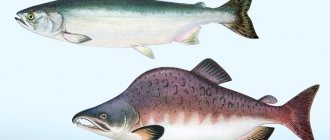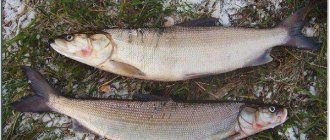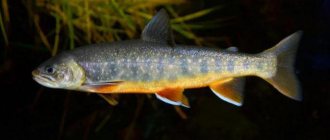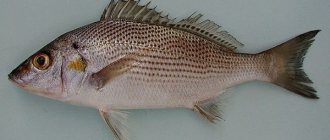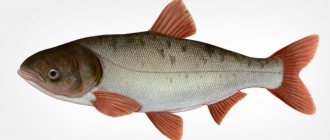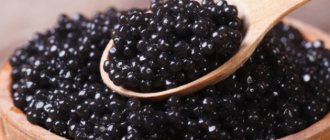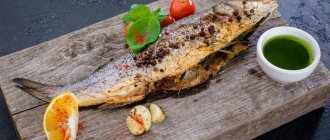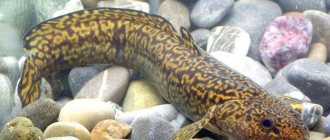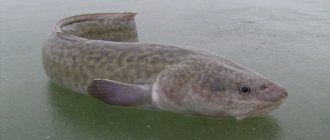Types of burbot
Burbot is the name given to fish from several genera. They are separated by habitat, but the individuals are similar in appearance and nutritional properties. The main types are marine and freshwater.
The first include:
- Black Sea or galea. Distributed in the Black Sea, rarely found in the Mediterranean and Azov Seas. Reaches a length of 50 cm.
- Mediterranean triwhisker. Lives in the Mediterranean Sea. Grows up to 35 cm.
- Menek. Found in the north Atlantic Ocean. Maximum length - 120 cm, weight - 30 kg.
The most abundant burbot is the common burbot, which lives in cold rivers and lakes. This is what is most often called simply “burbot”. This species is of industrial importance and grows up to 150 cm.
The thin-tailed burbot, the largest of these fish, also belongs to freshwater. Found in rivers of Russia. Weighs about 40 kg.
Burbot (Gaidropsarus vulgaris)
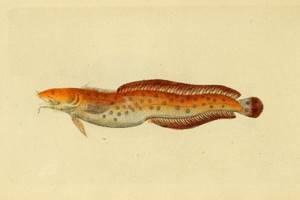
Mediterranean triwhisker (Gaidropsarus mediterraneus)

Freshwater common (Lota lota)
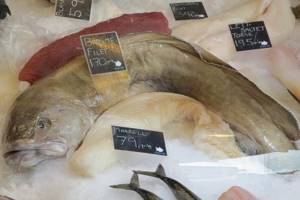
Burbot fish description
Burbot fish is considered the only species of the cod family and the spiny flounder genus that lives in cool fresh water.
Anyone who wants to catch fish must go fishing in inclement weather, when there is very poor lighting and the air temperature does not exceed 10 degrees Celsius (it is for this reason that it is not customary to catch fish in the summer months and during daylight hours).
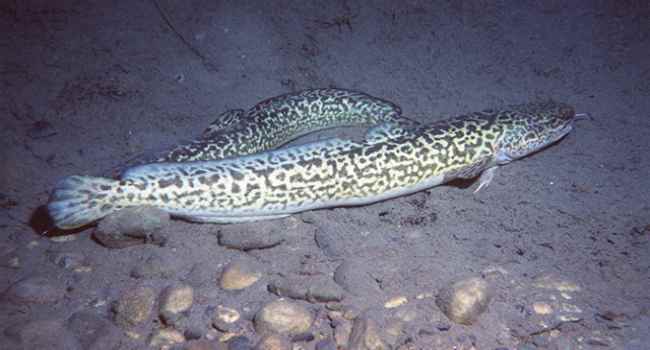
Although it is impossible to confuse burbot with other fish, some features are worth pointing out:
- The length of burbot can reach two meters, and the weight is about 32 kg;
- chooses rivers with a clay bottom for living;
- the body has a spindle-shaped round shape;
- its narrowing towards the tail is observed;
- the fish's head is quite wide, flattened (somewhat reminiscent of a frog's head);
- small yellow eyes with large dark pupils;
- one central antennae is noticeable on the chin;
- the mouth is large, with a large number of small teeth;
- a pair of antennae is also present near the nostrils;
- burbot's fins are not high, but long;
- the scales are small and covered with a thick layer of mucus;
- the overall color of the fish varies from grayish-green to olive-green or black-gray (it all depends on the age and the water in which it lives);
- the belly, pelvic fins, and throat of the fish are whitish or yellowish in color;
- the body has spots (or stripes) of a dark brown color.
Burbot is a predatory and voracious fish. A mouth full of teeth is just what they need to hunt other, smaller species of fish. And not only. Due to the fact that burbot is a predatory species of fish, its diet includes crayfish, worms, and frogs. Sometimes there are mentions that this fish can eat snakes and birds that live in reservoirs, in general, everything that they see on their hunt, with whom and what they encounter. Perhaps because of this, many fishermen prefer to release burbot back into the water, and it does not have much commercial interest.
And where river trout is found, the amount of burbot is specially reduced. Otherwise, you may be left without trout, a more valuable fish from a nutritional point of view.
Burbot reaches sexual maturity at 4-7 years, which depends on living conditions.
Spawning usually occurs between December and March, often under ice at very low water temperatures of 1 to 4 degrees.
The spawning itself is interesting. Several dozen male and female fish form a ball, with a diameter of half a meter to several meters, and in such a “clump” they roll along the bottom, releasing eggs and sperm at the same time.
The spawning itself lasts a very short period, no more than 2-3 weeks. Burbot does not have a specific place for spawning, and often releases its eggs simply into the water. The incubation period ranges from 30 to 128 days. Fertilized eggs drift in the water until they settle into cracks and voids at the bottom of the reservoir.
The number of eggs in a female burbot can vary depending on body size, age and water temperature and ranges from 63,000 to 3,478,000. The size of the eggs is approximately 1 mm.
Burbot fry grow quickly in the first year and by the end of the year can reach a length of about 11-12 centimeters. In the second and subsequent years, burbot grows by about 10 centimeters.
The fry are usually active at night. By the end of the night, they hide under stones and other objects at the bottom of the reservoir.
Beneficial features
Burbot is suitable for canning, frying, smoking, and drying. But it is better to eat boiled, steamed, baked and stewed fish. Such a product retains maximum healing properties and undergoes heat treatment necessary to prevent harm from parasites.
Why burbot is useful:
- Reduces the likelihood of high cholesterol levels.
- Strengthens coronary arteries and other vessels.
- Supports visual acuity.
- Reduces the risk of bone fragility.
- Increases the body's immune defense.
- Accelerates recovery after physical and mental work.
- Improves brain activity.
- Prevents the development of neurological disorders.
- Prevents early aging.
- Helps eliminate endocrine disorders.
- Promotes tissue healing.
- Improves the condition of the nervous system.

Impact on women and men
Fish helps normalize metabolic processes in the skin, so cosmetologists recommend that women consume it 2 times a week. The product prevents the formation of acne, stimulates the smoothing of wrinkles, and reduces the process of photoaging.
The benefits of burbot for ladies also include the following:
- normalization of hormonal levels;
- prevention of menstrual irregularities;
- reducing the likelihood of developing osteoporosis during menopause.
It is useful for men to eat burbot to accelerate muscle growth, improve potency and the condition of the reproductive system. Fish normalizes blood circulation in the pelvic area, saturates the body with easily digestible proteins and substances necessary to maintain activity and improve the quality of sperm.
Contraindications, possible harm
Absolute contraindications for use are allergies to cod and increased sensitivity to substances contained in meat and offal. A healthy person can eat 150–200 g of fish 3–4 times a week. When introduced daily into the diet, the daily norm should be 100 g.
Exceeding the recommended portions leads to an excess of protein in the body. Side effects:
- heaviness in the stomach, gas formation;
- nausea, vomiting;
- weakness;
- headache;
- increased body temperature;
- dysfunction of the liver and kidneys.
Burbot cooked without heat treatment can have a harmful effect. Fish often become carriers of parasites. When consuming a contaminated product, there is a high probability of tapeworm larvae entering the human body.
Pregnant and lactating
Pregnant women benefit from boiled and baked burbot meat to improve health and prevent the development of pathologies in the child.
The product helps replenish calcium, folic acid, iron, magnesium, therefore:
- promotes the normal formation of the fetal neural tube;
- eliminates the risk of anemia;
- prevents tooth decay;
- reduces uterine excitability;
- helps eliminate nervousness;
- improves the functioning of the gastrointestinal tract.
Restrictions for use during pregnancy:
- having an allergy to fish;
- excess calcium and iodine in the body.
In the absence of pathologies, fish is allowed 2 times a week, 150–200 g each. If the expectant mother is prone to edema, the product should be prepared without salt.
During breastfeeding, burbot can also be included in the diet. Fish promotes rapid recovery after childbirth, saturates mother's milk with vitamins and minerals that are beneficial for the baby, and helps improve lactation. The product should be boiled, steamed or baked in the oven 1-2 times a week for 150-200 g.

Is it possible for children
Burbot can be introduced into children's diets from the age of 1 year. The fish is not bony and the fillet separates easily.
Benefits for the child:
- strengthens bones;
- promotes the formation of healthy baby teeth;
- prevents the formation of rickets;
- accelerates the development of thought processes;
- improves memory;
- reduces the risk of colds.
For the first time, the baby should be given 1 teaspoon of boiled burbot. If he does not develop an allergy, the daily norm can be increased to 50 g per day, 2 times a week. It is useful for children to make steamed fish cutlets, stew and bake fillets with vegetables. From 7 years old, the daily norm should be increased to 70 g, from 14 - to 100 g.
Where is burbot found?
The main habitats of this fish are freshwater rivers and lakes of northern latitudes. It can enter slightly brackish waters to spawn.
It is widespread in European countries, excluding the very southern Balkans, Italy and Greece, Canada, the United States, Alaska, and England.
Here it can be found almost throughout the entire territory, right up to the Black and Caspian Seas, in the waters of almost all Siberian rivers, right up to Anadyr. It is found on the island of Yamal with the exception of the northernmost point. It will be easier to say where there is no burbot. If you want to catch this fish, you don’t need to go far from your place of permanent residence. Moreover, they are not at all demanding of living conditions: they feel good and, most importantly, safely in clayey silt, sandy bottom, gravel, under stones and boulders, where they make large “houses” for themselves to hide in during the daytime.
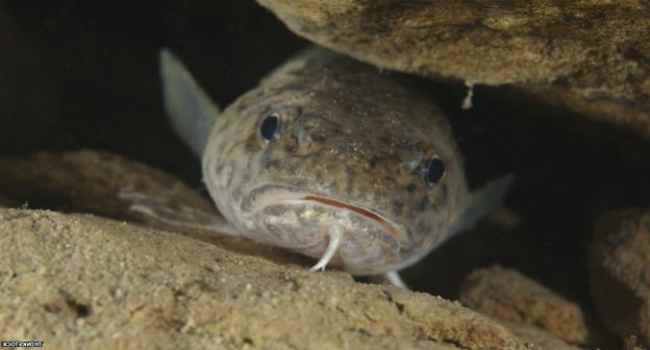
Recommendations from nutritionists for losing weight
Burbot is a low-fat fish, but at the same time it satisfies hunger well and gives a feeling of fullness. It can be consumed without the risk of subcutaneous deposits. Burbot has other beneficial properties for a person on a diet:
- acceleration of metabolism;
- improving the functioning of internal organs;
- increased mood;
- preventing the consequences of reducing the nutritional value of the diet.
When losing weight, fish should be boiled and cooked in a double boiler. You can include it in the menu every day, 100 g or 200 g 3 times a week.
Chemical composition, calorie content
The calorie content of 100 g of burbot meat, depending on the time of catch and habitat, is 81–88 kcal. Protein in such a serving is 18.5-19 g, fat - 0.6-0.8 g. Raw fish does not contain carbohydrates.
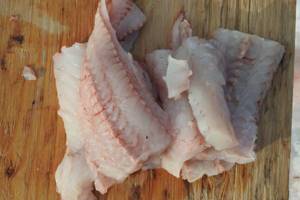
Burbot contains vitamins A, B1, B2, B5, B6, B9, B12, PP, E, D, omega-3 and omega-6, saturated and polyunsaturated fatty acids.
The amount of macro and microelements in 100 g of fillet is:
- potassium - 270 mg;
- phosphorus - 191 mg;
- sulfur - 188 mg;
- sodium - 97 mg;
- magnesium - 64 mg;
- calcium - 32 mg;
- iron - 1.4 mg;
- zinc - 0.76 mg;
- manganese - 0.7 mg;
- nickel - 430 mcg;
- copper - 200 mcg;
- chromium - 55 mcg;
- selenium - 12.6 mcg.
The energy nutritional value of burbot changes during the cooking process. Examples of calorie content depending on the processing method and type of product:
| Cooking method | Kcal per 100 g |
| Cooking | 92 |
| For a couple | 88 |
| Baking | 87 |
| Frying with oil | 173 |
| Smoking | 92 |
| Liver | 613 |
| Caviar | 115 |
| Canned food in tomato | 110 |
| Canned food (pieces in oil) | 175 |
Differences from other fish
Due to the external similarity, burbot is often confused with catfish. But these fish belong to different families and have specific benefits for the body:
- Catfish meat is fattier and higher in calories, contains more omega acids, calcium, phosphorus, vitamins A, E, C.
- Burbot is better saturated with iron, zinc, selenium, B vitamins, potassium, and magnesium.
- Catfish fillet is healthier for teeth, bones, and vision. Has a stronger rejuvenating effect.
- Cod meat relieves anemia faster, helps better with heart disease, and is more effective for male potency.
A special feature of burbot is also the calorie content of the liver, which contains a lot of omega-3 fatty acids.

Som
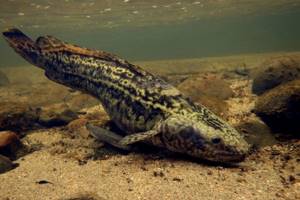
This fish is also different from other waterfowl. Examples of key properties:
- Roach. It is inferior to burbot in the amount of macro and microelements and vitamins, but superior in the concentration of nicotinic acid. It has the ability to prevent blood clots, but is less useful for the skeletal system, strengthening the immune system, restoring cells and preventing aging.
- Zander. It is superior in the amount of iodine, vitamins A, E, C, B9, but inferior in saturation with potassium, magnesium, iron, and manganese. Burbot helps better with anemia and heart problems.
- Carp. It differs in that it is indiscriminate in its diet and can live in heavily polluted water bodies. Capable of accumulating heavy metals in the body. Burbot is not inclined to this.
- Crucian carp. Contains more calcium, phosphorus, vitamin A, but the cod representative is more saturated with other types of vitamins and iron, therefore it is more useful during pregnancy. The advantage of burbot is also that it has fewer bones.
- Pike. Fish grown in a clean reservoir has a large set of vitamins, but when living in dirty water, it accumulates harmful substances in the meat. Burbot is better saturated with macro and microelements, which strengthen the walls of blood vessels, increase hemoglobin, and normalize the water-salt balance in the body.
Burbot
Olga Syutkina, historian of Russian cuisine, co-author of the books “The Uninvented History of Russian Cuisine” and “The Uninvented History of Russian Products”:
“Bubot is not often used in Russian cuisine, but its history without this fish would be incomplete.
Burbot fish soup is mentioned in Domostroy, and this is the middle of the 16th century. Men, or menek, that’s what they called him back then. At the beginning of the 19th century, Vasily Levshin in the book “Russian Cookery” writes: “If you can have burbot livers, put them on top of the minced meat, this will give the kulebyak an excellent taste.” I tried it and it’s true, the taste is amazing. You can hardly feel the liver in the filling, but the pie becomes very juicy and aromatic. Levshin also wrote that burbot goes into lean soups and sauces, but “the livers are especially respected.”
They are respected for their fat content and size. Burbot is, in principle, a fatty fish, but it feels like all its fat is concentrated in the liver. The same applies to the more common cod liver, but cod has a denser liver, and burbot is fuzzy, pate-like, more aromatic and, in my opinion, more tasty. Burbot meat is similar in taste to catfish meat, although, in fact, burbot is a cod fish. Cod is drier, but it has a similar meat consistency to burbot: when pressed, it breaks into large slices.
For all its advantages, burbot is a rare guest in public catering. You won't find it in restaurant directories. Ignatius Radetzky, in his monumental work on the structure of St. Petersburg cuisine, gives a single recipe - sterlet fish soup with burbot livers. Moreover, there are a lot of dishes made from smelt, vendace or roach. It’s difficult to say why burbot is so inconvenient. I can only guess. Firstly, this is a very seasonal fish; for example, near St. Petersburg it is caught only in December. Secondly, it is difficult to catch - it hides under snags. And burbots are individuals. That is, they do not travel in packs. Pike and catfish too - but at least they are bred in artificial reservoirs. They say that the La Marée company also offers some burbot of standard size and weight, but I have not tried them yet.
Admittedly, burbot can smell like mud. And if it’s enough to clean the catfish of mucus and rub it with salt, then this thing won’t work with burbot. Finally, burbots are often found infected with helminths, and the liver must be carefully examined so that there are no blisters on it. They probably become infected because they lie in the mud and feed on carrion. To be honest, I tried good burbot for the first time relatively recently, and it was brought from some rivers in the Perm region.
From the point of view of consumption, burbot is an ordinary river fish, and it must be handled accordingly: boil soups, fry, bake. In the 19th century, burbot liver was placed in sautés and pates, in side dishes and matlots. And fatty meat was mainly used for pies.
I really love burbot pies. Usually you want to make a pie for many guests, and not for two or three people; you can’t get burbot in such large quantities, so I use pike perch with it: it’s available, and it also absorbs flavors well and looks beautiful. I take the dough, yeast or puff pastry, put slices of boiled potatoes on it, slices of fish on top, then thinly sliced liver (after baking there will be practically no trace left of it), sprinkle with herbs, cover with a second layer of dough (be sure to make a hole so that steam went out). And the head, tails and bones fit my ear.
Burbot meat can also be baked or made into matlot (I cook burbot with red wine, just like carp). And the liver can be added to fish pastes, and simply put as a side dish. The only thing: fried burbot liver will be too fatty - I advise you to bake it.”
Benefits and harms in diseases
Recommendations for the preparation and consumption of burbot for the prevention and treatment of diseases:
- Diabetes. Fish helps maintain normal cholesterol levels and does not contain carbohydrates that stimulate high blood sugar. Only boiled and baked burbot brings benefits. You can eat 100 g of it 5-6 times a week. Fried, canned and smoked fish are contraindicated for diabetes: they saturate the body with harmful cholesterol.
- Arthritis. Burbot helps prevent inflammation of the joints and stop their destruction, as it contains polyunsaturated fats and B vitamins. It is useful for the patient to consume 200 g of stewed with vegetables, baked or boiled product 2-3 times every 7 days.
- Osteoporosis. Fish fillet can saturate the human body with calcium, phosphorus, and vitamin D, which are necessary to prevent bone destruction. It is better to eat 150 g of stewed, baked or boiled burbot 3-4 times a week.
- Cardiovascular diseases. Fish is useful for the prevention of atherosclerosis, stroke, heart attack, and coronary artery disease. The product helps maintain normal blood pressure and blood circulation, eliminate the risk of narrowing and blockage of blood vessels, and maintain their elasticity. To prevent pathology, it is allowed to consume burbot up to 5 times a week, 100–150 g each. The fish must be boiled, steamed, baked or stewed.
- Neurological diseases. The presence of fish in the diet helps relieve nervous tension, reduce the risk of destruction of brain cells, get rid of insomnia, stop inflammation and reduce the rate of spread of infections that cause pathologies. Burbot should be consumed 2 times a week, 200 g, boiled, baked or stewed.
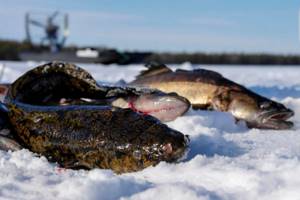
On winter fishing
Use in folk medicine
Healers from Asia and Europe used burbot to treat various pathologies along with medicinal herbs.
Examples of using fish:
- Cataract. When identifying a disease, burbot liver fat is useful. To restore vision, you need to instill 1 drop of the product into your eyes for a month.
- Frostbite. For skin lesions, a recipe from Yakut healers is effective: mix raw burbot liver with butter in equal parts and apply to the problem area. As an alternative, you can simply apply pieces of raw offal to the frostbitten area.
- Alcohol addiction. Traditional healers noted that burbot secretes mucus, which can relieve cravings for alcohol. To eliminate the pathology, the patient needs to eat fish meat daily.
- Thyroid diseases. Broth made from freshly caught burbot helps get rid of the problem. The medicine should be prepared only from fish and water and taken every day.
- Hernia. For treatment, you need to drink 500 ml of fresh fish broth daily. Cook the burbot over low heat in a small amount of water for 3 hours.

Recipes for preparing delicious burbot dishes at home
In the oven
Fish according to this recipe can also be cooked in a slow cooker, preferably in foil, so that the fish retains its juiciness and aroma of spices.
Ingredients:
- Fish;
- Bulb onions;
- Tomatoes;
- Carrot;
- Herbs and other spices.
- Clean the fish carcass, rinse it under water, make sure that there are no traces of the insides left.
- Remove moisture if possible, and then rub the fish with salt, pepper and other spices to taste. The fish must be left for half an hour to soak.
- At this time, peel and cut the vegetables into small cubes. Greens too.
- After you have greased the baking sheet, place some vegetables on it, place the main ingredient on top and cover with the remaining vegetable part.
- Approximate baking time is 15-20 minutes.
This fish goes well with any side dish.
Ear
Ingredients:
- Burbot;
- Water;
- Potato;
- Carrot;
- Onion;
- Spices and herbs.
- Clean the burbot, remove the insides from the carcass and rinse thoroughly. Divide it into parts and place it in boiling water, salted in advance.
- Chop the peeled potatoes not very finely, cut the carrots into circles and onion into half rings.
- Add vegetables to the simmering broth.
- Usually, many spices are not added to the fish soup, except peppercorns. In return, you can add delicious burbot liver and raw milk there.
- Throw in some allspice and hot pepper and a couple of bay leaves.
- Chopped greens, parsley and dill are added before cooking.
- The fish soup is cooked for 30 minutes.
On coals
Ingredients:
- Burbot;
- Onion;
- Spices.
- Clean the burbot carcass, cut off its head and remove the scales and separate the fillet from the bone. Divide the fillet into large pieces.
- Grind the onion in a blender or grate it. Add salt and pepper to the resulting slurry, and a little herbs if desired.
- Coat each piece and let them sit for about 40 minutes so that the fillet is well soaked.
- Place fillet pieces on a skewer and fry until fully cooked.
In what form is it sold, how to choose
In stores you can find the following types of product:
- Chilled carcasses. They are often found in retail outlets located close to where they were caught. A fresh product has bright red gills, moist, clear eyes, elastic meat without dents or creases, and shiny smooth skin. You can store carcasses for 48 hours in the refrigerator if you first cover them with ice.
- Frozen fish. When purchasing, you should pay attention to signs indicating improper storage and the likelihood of repeated freezing. If the fish has been frozen repeatedly, it will have sunken eyes, dried fins, and red streaks on the body. Such carcasses are poorly separated from the general layer. The product can be stored in an ice crust for 6 months in the freezer.
- Smoked. It takes on a dark straw hue and an aroma reminiscent of wood smoke. Prepared using cold and hot methods. When choosing such a product, you need to pay attention to the smell and color of the meat. If the carcasses are richly golden and have a sour aroma, these are signs of the use of artificial smoke, which can cause allergies and provoke gastrointestinal dysfunction. However, even burbot prepared in the classical way is harmful to the body. During the smoking process, the product is saturated with carcinogens that activate the formation of cancer cells, so frequent consumption increases the risk of developing cancer.
- Canned. Burbot is sold in tomato sauce, natural with oil or fried. The product made from fresh fish tastes better. But according to GOST, it can also be made from frozen raw materials, but in this case the pieces of fish are less juicy. Canned food is tasty, convenient to use, but does not have medicinal properties. During cooking, burbot loses some of its beneficial compounds and becomes high in calories. Also, if handled incorrectly, bacteria can enter the jars and cause poisoning.

Benefits and harms of burbot liver, research
100 g of burbot liver contains 65.7 g of fat, the main part of which consists of polyunsaturated, saturated and omega acids. A serving of the product also contained 4.2 g of protein, 1.2 g of carbohydrates, vitamins E, D, A, PP, C, B9, potassium, iron, calcium, magnesium, sodium, fluorine, chromium, molybdenum, chlorine. The concentration of nutrients is 2–4 times higher than in meat.
The liver is used in cooking, medicine, and cosmetology. Dietary supplements are prepared from fat, and extracts from the product are added to anti-aging creams and hair strengthening products.
What are the benefits of burbot liver:
- Increases the body's resistance to viruses and bacteria.
- Helps normalize blood cholesterol levels.
- Stimulates memory and ability to concentrate.
- Strengthens the walls of blood vessels.
- Helps relieve inflammation.
- Prevents and treats skin diseases.
- Prevents the development of tuberculosis and neurological pathologies.
But the product is dangerous if the gastrointestinal tract and pancreas are disrupted. The reason is that the breakdown of fats requires a large amount of enzymes, which the diseased organ is not able to produce. It is also necessary to adhere to the daily norm. To improve the health of the body, it is allowed to eat up to 30–40 g. If abused, diarrhea, disruption of the stomach and kidneys can occur.
The benefits of burbot liver have been proven by scientific research. So, in 2008, experts from Canada reported on the results of an analysis of fat extracted from the product. They found that in terms of the amount of omega-3 acids, vitamins A, K, D, burbot liver is not inferior to cod liver, which is considered the standard for useful qualities.
After studying the composition of the product, experts concluded: it can be used as the main source for the production of food supplements with fatty acids and vitamins.
Fish liver can be fried and breaded, but it is healthier to boil it and make pates or add it to vegetable salads. However, most often the product is found in canned food. It is produced under the trademarks “Legend of Yamal”, “Yamal”, “Salekhard Plant”, Syberia, “Bering”.
Canned liver can also be useful, since most of the omega acids are preserved during cooking, but if processing rules are violated, oxidative processes can be activated. In this case, the product becomes dangerous, causing disruption of the stomach and food poisoning.
The benefits of caviar, milk, bile
Burbot caviar is rich in iron, phosphorus, potassium, sulfur, magnesium, fatty acids, vitamins A, B1, B2, B6, B9, C, PP, E. It helps increase hemoglobin, improve heart function, relieve inflammation, protect brain cells from damage, maintain skin elasticity and hair beauty.
Caviar in burbot is rare, since it is prohibited to catch fish during spawning. But if such a product is caught in a carcass, it can be salted, fried, or baked. You should eat up to 40 g of caviar per day.
Burbot milk has a high protein concentration and low calorie content. The product is useful for men to increase potency. It also helps support the functions of the autonomic system, improve skin condition, and restore liver cells. Milk is tasty when salted, baked and fried, but when using the latter method of preparation, the product becomes higher in calories.
Traditional healers have long used fish bile to treat diseases. For example, there are recipes for the treatment of colitis. To eliminate acute attacks, you need to swallow 1 bottle on an empty stomach for several days. It is believed that burbot bile helps eliminate liver pathologies. The disadvantage of these methods is the lack of confirmation from official medicine.
Tips for choosing and cutting
In order for your cooked burbot to be tasty and smell appetizing, first of all, it must be fresh and, if you were unable to catch burbot, go fishing in supermarkets in search of fresh fish.
For fresh burbot:
- its small scales adhere tightly to the skin;
- it has dense meat, which indicates 100% freshness;
- All fresh fish have bright red or scarlet gills.
Please note: also the eyes, they should be clear, the aquatic inhabitant should have a natural smell. The fish oil should be all in the liver, otherwise freezing too fatty fish will cause it to lose its taste.
What products does it combine with?
You can cook burbot with classic fish seasonings, spicy, tomato and sour cream sauces, vegetables, and cereals. When preparing dishes, you should take into account the compatibility of products. The wrong combination leads to the fact that low-fat fish becomes difficult to digest, causes dysfunction of the stomach and exacerbation of gastrointestinal diseases.
Poor combination of components can also reduce the usefulness of burbot.
For example, when processing fish with alcohol-containing dressings, B vitamins are destroyed and a barrier is created for the absorption of tocopherol and retinol. Compatibility table with other products
| Fine | Ghee, whey, greens, cabbage, carrots, beets, pickles, green vegetables |
| Acceptable | Rice, buckwheat, lemon, quinoa, tomatoes, butter, vegetable oil, pumpkin, eggplant, zucchini |
| Badly | Meat, poultry, eggs, mushrooms, cream, sour cream, lard, nuts, seeds, potatoes, dairy products, cheeses, feta cheese, wheat, rye, oats, bread, peas, chickpeas, mung beans, beans, beans, lentils. |
Cooking features, recipes
Burbot has thin and small scales, but tough skin that must be removed before cooking.
- Rub the carcass with coarse salt to remove mucus and rinse with cool running water.
- Use special scissors to remove all fins.
- We make a shallow cut around the head, pry the skin with your fingers or pliers and remove it like a stocking. If the skin does not come off somewhere, cut it at the bottom with a sharp knife.
- We insert the knife shallowly in the area of the anal fin and move it to the base of the head.
- We take out the insides with our hands, clean out the dark films, and rinse the carcass with cold water.
- If the fish is going to be cooked with its head, we tear out the gills.
For cooking, it is better to choose small carcasses. The larger the burbot, the drier and tougher the meat. Properly processed fish has a sweetish taste and white meat.
Classic recipes:
In a frying pan
Ingredients:
- 2 kg of gutted and cleaned fish;
- 100 g white flour;
- 50 ml vegetable oil;
- 2 tablespoons potato starch;
- salt, spices to taste.
Preparation:
- Separate the fish from the bones, cut into large pieces, sprinkle with spices and salt, and leave to marinate for 20 minutes.
- Roll each portion of burbot in starch, then in flour.
- In a frying pan heated in oil, fry on each side for 3-5 minutes.

In the oven
Ingredients:
- 500 g burbot fillet;
- 2 tomatoes;
- 1 medium onion;
- 1 sweet pepper;
- a bunch of parsley;
- half a lemon;
- 2 tablespoons olive oil;
- salt.
Preparation:
- Wash the greens and vegetables, chop them, put them in a deep container. Stir and season with lemon juice.
- Salt the fish fillet and grease with vegetable oil.
- Place foil on a baking sheet, place fish and vegetables, and wrap.
- Bake in the oven for 30 minutes.
In a slow cooker
Ingredients:
- 1.5 kg of burbot;
- 2 onions;
- 2 carrots;
- 2 cloves of garlic;
- 100 g sour cream;
- seasonings and salt to taste;
- sprig of rosemary.
Preparation:
- Clean the fish, cut into pieces 2.5 cm wide, salt and sprinkle with spices.
- Wash and chop the vegetables, grate the garlic, mix.
- Place half of the vegetables on the bottom of the multicooker, then the burbot and the rest of the preparations.
- Pour sour cream over the food and put rosemary on top.
- Close the multicooker bowl and cook in the “Stew” mode for 45–50 minutes.
On the grill
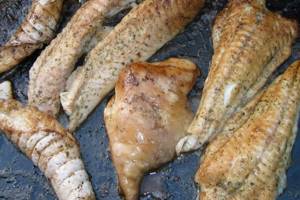
Ingredients:
- 800 g burbot steaks;
- 1 small onion;
- 2 tablespoons of full-fat kefir;
- 1 tablespoon lemon juice;
- salt pepper.
Preparation:
- Grind the onion in a blender and pour into a deep bowl. Add spices, salt, kefir, citrus juice.
- Marinate the fish steaks in the resulting mixture for 2 hours.
- Place the burbot on the grill grate. Fry for 8–9 minutes on each side.
Liver pate
Ingredients:
- 350 g fish by-product;
- 2 liters of water;
- 1 onion and carrot each;
- 2 eggs;
- 1 tablespoon vegetable oil;
- salt, ground black pepper.
Preparation:
- We wash the liver and boil it in 2 liters of salted water for 30 minutes.
- We clean the vegetables, cut them, and saute them in a frying pan until softened.
- Boil and peel the eggs.
- Grind the cooled liver in a blender. Add vegetables, eggs, pepper, 1-2 tablespoons of the broth in which the offal was cooked to the bowl of the device, grind until a homogeneous mass is formed.
Alternative method of cleaning and cutting
This method differs little from the previous one, except that here the burbot skin is removed at the very end. This method of cutting fish is well suited if you subsequently plan to fry it or mince it. So, how to clean burbot for frying .
- This method of cleaning and cutting begins with gutting, which is carried out according to the standard procedure.
- The gutted and washed inside fish must be carefully cut into two halves and the head cut off.
- Using tweezers, all large bones are removed. This will take time and some skill.
- And at the very end, you need to remove the skin from the cut fish using pliers.
Brief conclusion
Burbot is a low-fat fish with medicinal properties. Helps cope with chronic diseases, strengthen the immune system, and activate the brain. Offal products are also useful - caviar, liver, milt.
However, to improve your health, you need to prepare them correctly and follow the recommended daily portions. Smoked burbot can cause allergies and provoke malignant changes in cells, and exceeding the recommended intake of fish leads to an overdose of protein and disruption of the stomach.
Methods for preparing burbot
From the point of view of benefits and culinary value, preference should be given to fresh burbot. After freezing, meat loses its juicy and tender taste, and some beneficial substances begin to deteriorate.
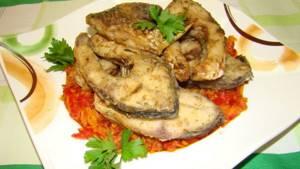
Fish milk and liver are considered a delicacy.
The main task of a cook or housewife who decides to serve a burbot dish is to preserve the nutritional value, taste and benefits of the fish. You can prepare it in various ways:
- Meat baked in the oven. Good recipes for burbot with vegetables, which can be supplemented with a variety of sauces, for example, sour cream or cream. Fish stuffed with mushrooms or seasoned with vegetables is served at the festive table.
- Steaks, fillets, fried in a pan. They can also be cooked in a slow cooker.
- Meat fried in batter, as well as fish cutlets, have excellent taste.
- Burbot can be a good basis for preparing aspic, as well as fish soup and fish broths.
- Canned stewed meat. It is supplemented with sour cream, tomato paste, cream, and vegetables. The dishes have a delicate taste.

